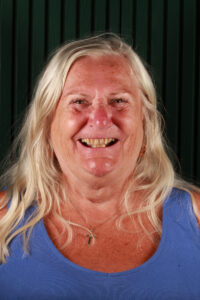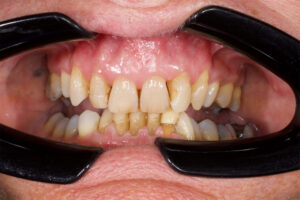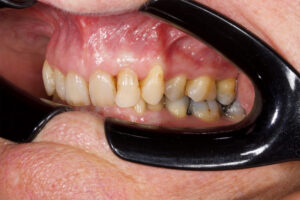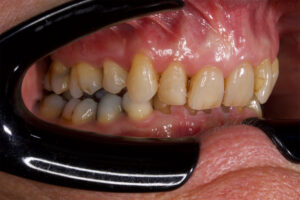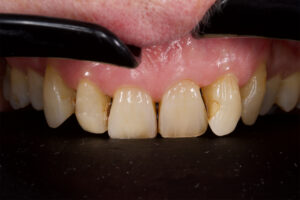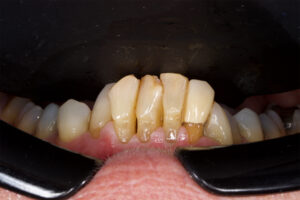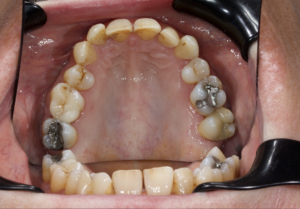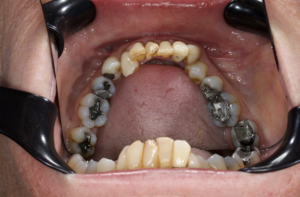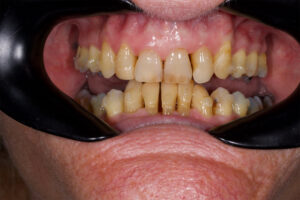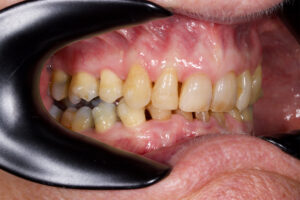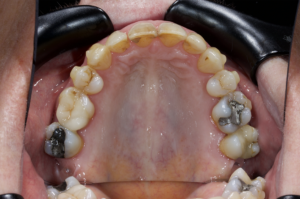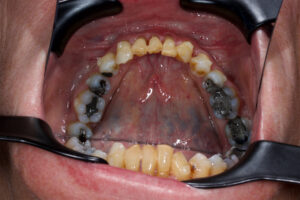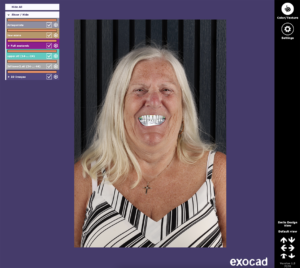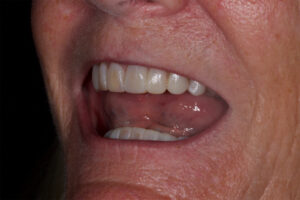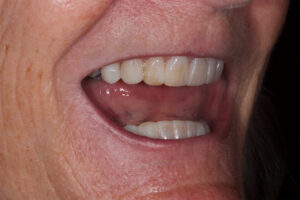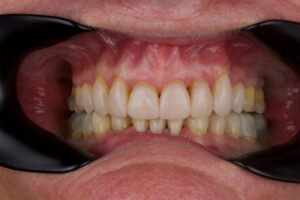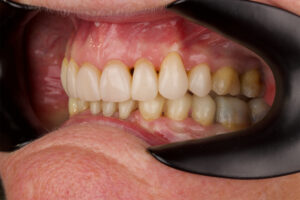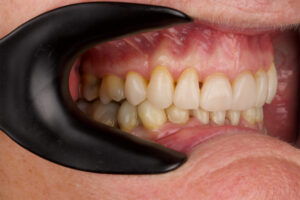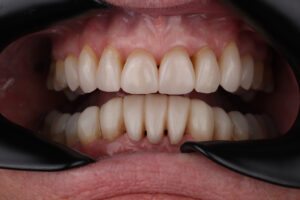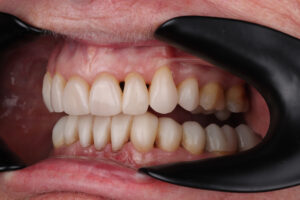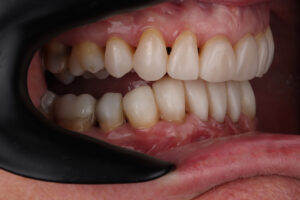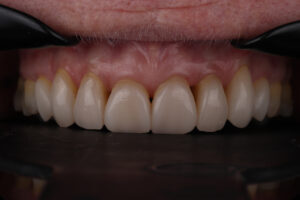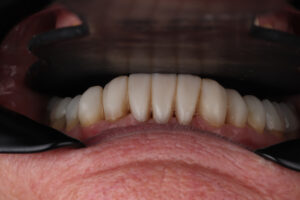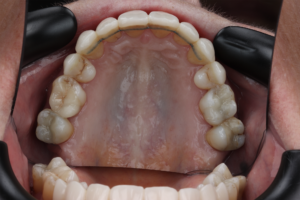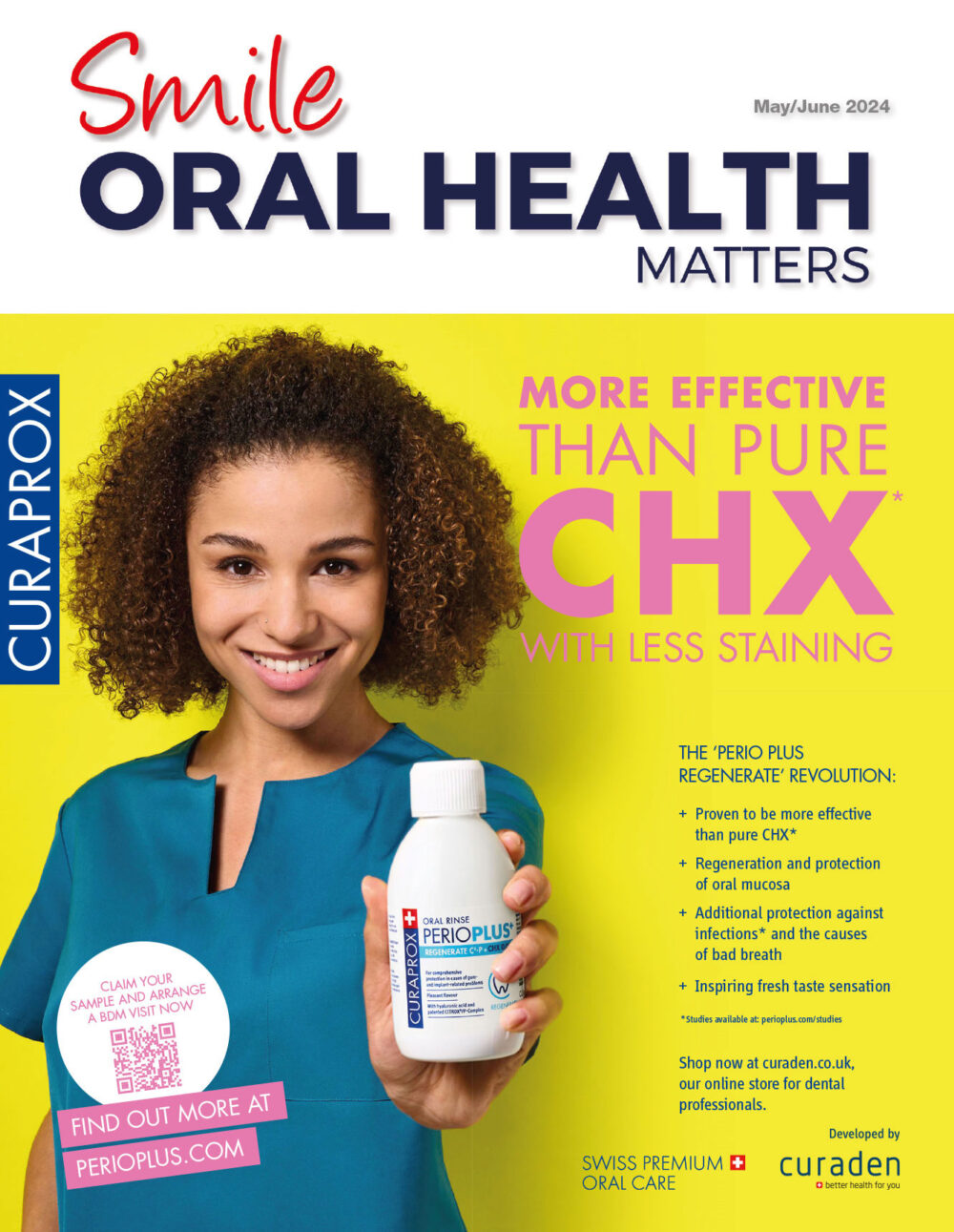Patient background
The patient was referred to the practice because she had a deep bite which was traumatic to the soft tissue. She complained that her bottom teeth were biting into the roof of her mouth, which frequently gave her painful gums and made food very difficult to eat. She also didn’t like the appearance of her teeth, the shade in particular, and was interested in achieving a whiter smile. The patient was resistant to having orthodontics, and was keen to consider replacement of teeth as she felt it may improve her chewing.
She had already been made aware that she had gingival disease, and was undergoing regular therapy within the practice. I offered her oral hygiene advice to help her manage this, and it was taken into account throughout her treatment planning and provision.
Assessment and diagnosis
Full mouth X-rays were carried out which radiographically revealed minor bone loss everywhere apart from 40% bone loss in the lower anterior region. A Basic Periodontal Examination (BPE) was carried out which found BPE scores of 323 in the upper teeth, and 323 in the lowers. The patient also had a root treated LL2, which had a poor prognosis.
Treatment planning
As always, the patient had the option not to proceed with treatment, however this was not recommended in her case, as restorative treatment would drastically improve her situation.
Treatment options discussed included removing the LL2, and using this space strategically to relive the crowding. Orthodontic treatment was also recommended to correct the patient’s deep bite. This was carried out using the Invisalign system, rather than a fixed solution, which was an acceptable solution for the patient. The LL2 would be removed prior to this, and the lower anterior teeth would be restored and a fixed retainer provided. Posterior adhesive onlay were planned for the right hand side with conventional crowns at an increased occlusal vertical dimension (OVD) with the aim to open the patient’s bite.
Treatment provision
To begin with, the LL2 was removed and orthodontic treatment started using Invisalign clear aligners. This process took approximately 10-11 months, beginning in July 22 and finishing in May 23. This treatment step was successful; the patient’s deep bite was improved, and a favourable alignment was achieved.
Once orthodontic treatment was complete, a new set of dental records were taken, and a multibite record of the patient at an increased OVD in a deprogramed state. A digital plan was created using SmileFast refine stage at the increased OVD. This plan was used to create a trial smile, which was transferred into the mouth using a bisacryl adhesive material (Luxatemp). This is a great way to allow the patient to get a feel for their new smile, and creates an opportunity to make any necessary changes or adjustments to the restorations and occlusion before fabricating the final products.
Proceeding with treatment, the height of the lower anterior teeth was reduced to help with aesthetics, and they were then restored directly using BRILLIANT Everglow™ composite from COLTENE in shade A1. UR4 to UL4 were restored using the SmileFast Styloso product, which utilises two preparation stents (where needed) to minimise the amount of prep required, it is done on the day of fitting the veneers. The indirect BRILLIANT Crios veneers from COLTENE in shade A1 are transferred onto the teeth with a jig to ensure perfect seating. The veneers were cemented with One Coat 7 Universal adhesive applied and cemented in with flowable composite. Composite bonding was also carried out on the UR6 and UL7, as well as monolithic zirconia crowns (made by Xclusive Dental Lab, Birmingham) placed on the LR6 and LL6. LL6 was prepared, prior to crown placement, whereas the LR6 was not prepared, using One Coat universal and Panavia to apply the crown directly to the tooth.
Following this, fixed retainers were applied to the lingual surfaces of the upper and lower anterior teeth to help maintain the alignment achieved during orthodontic treatment and 3 sets of Vivera retainers were fabricated.
Outcome
The patient was delighted with her results. The original aims of her treatment were met, removing the lower tooth with the poor prognosis, achieving a favourable alignment, restoring the dentition to improve function and aesthetics, and transforming the overall appearance of her smile. I was also happy with the treatment outcome in this case. Ongoing maintenance and oral hygiene will be needed to maintain this result.
Case appraisal and reasoning
The option to restore this in porcelain would have been the more traditional method here following pre-restorative orthodontics, however, due to cost, and a dramatic change in OVD and occlusion, combined with her age meant I felt using composite would give us the best adaptability for this treatment if, for some reason, it wasn’t tolerated well.
She doesn’t have any parafunctional habits that would concern me about breakages and the occlusion was checked to ensure guidance was suitable.
BRILLIANT Crios was chosen, as she had a diet which was more susceptible to staining, and with Crios being milled and polished out of the mouth, it meant we could guarantee fully cured polished composite, which is inherently much more resistant to staining. The lower incisors, with her lower aesthetic concern of these, were done with direct composite in a SmileFast stent (SmileFast Direct) which allows for greater planning and ease of occlusal control.
Key learning points and advice:
These cases which were once difficult can now be managed easier with the use of digital technology, and with milled composite, it is possible to get superb, less technique sensitive results and improve the cosmetic results many dentists struggle to achieve in-vivo.
COLTENE has a wide range of products on offer which enable dentists to carry out restorative treatments to a high standard. With a product range including BRILLIANT Everglow™ and BRILLIANT Crios to support both direct and indirect solutions, COLTENE understands what it takes to achieve excellent outcomes.
For more information, info.uk@coltene.com and 0800 254 5115
Author bio:
Dr Rajiv Ruwala qualified from King’s College London in 2008. He is a Principal Dentist and Complex Restorative and Implant Dentist, and currently runs 2 Green Dental, 2 Green Dental boutique and Figges Marsh Dental in Dartford and Mitcham. He offers surgical dentistry including implants and gum grafting surgery, as well as smile makeovers, orthodontics, and general dentistry. Rajiv is dedicated to teaching. He has received a PgCert for Dental Education from the University of Bedfordshire, and has offered training and education through the London Deanery, King’s College Dental Institute, and BDA.
Here, he presents a restorative case which improved the function and aesthetics of his patient’s dentition.
